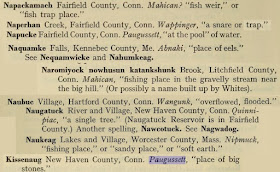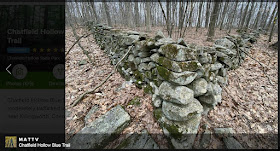Pages
Thursday, April 29, 2021
Stone Snake Effigy (Woodbury CT)
Thursday, April 22, 2021
Wednesday, April 21, 2021
Update on Nonnewaug
I can take a few educated guesses at just what the word Nonnewaug means.
Nonnewaug physically includes “the Nonnewaug floodplain,” literally dry land that once was a glacial lake perhaps. It was observed to be under cultivation by Indigenous People living at the Nonnewaug Wigwams in 1672 and up until 1740. There is also a now stranded and disturbed diagonal row of boulders in the river known as the Nonnewaug and perhaps you could say it was: “The fish weir farthest up the little river that joins up with the Great River at Pootatuck.”
Tuesday, April 13, 2021
Outcrop Serpent Effigy 001 (Cockaponset)
And a little more...
Friday, April 09, 2021
Glossary of a "Stone Prayer"
Káhtôquwuk/ Stone
Prayer
“Invested with prayers for the balance of the universe”
“Out of respect
for accuracy, intention, cultural sensitivity and right of peoples to govern their
self-narrative, Indigenous terms are here used to described things Indigenous.
The term "cairn" is specifically Gaelic/Gailidh and properly applies
to that cultural context. "Rock pile" was noted as inappropriate by
the Deputy Tribal Historic Preservation Officer of the Narragansett at a 2017
conference, since relics are sacred and "regarded as grandfathers."
Both preceding terms have been misapplied to Algonquian sacred relics, for
which Indigenous, accurately descriptive terms are given below. Following is a glossary
of terms in this article,” writes Nohham Rolf Cachat Schilling in Assessing Stone Relics in
Western Massachusetts Part II: Patterns of Site Distribution (2018, Bulletin of
the Archaeological Society of Connecticut)…
Name of
Algonquian nation + euw = name of Algonquian language (ex: Nipmeuw, Massachuseuw,
Lënapeuw, also spelled Lunapeeuw).
Kodtonquag(kash) - ceremonial stone grouping (káhtôquwuk, Narragansett), allegorically, a 'stone prayer.'
Máunumúet(ash) - place(s) of ceremonial
gathering (ehenda mawewink, Lënapeuw, mawighunk, Mahhekanneuw).
Hasennnípaü - "standing stone" (Nipmeuw; suns nipámu
Narragansett).
Wawanaquassik - honoring stones place (Mahhekanneok).
Wawanaquassuk - "Honoring Stones"
Manito(u), manitoiwuk
- a spirit being, of the spirit beings (a group, or some of the spirit beings).
Nípaü kodtonquag(kash) - stone groupings, either tabular or
round stones, stacked in upright courses on top of boulder bases (Nipmeuw).
Anogkuéu kodtonquag(kash) - barely elevated low mound of
concentric circles of smooth/round cobbles or very small stones, sometimes
variable as pebbles without organized rings (Nipmeuw).
"In regard to
stone features including 'massive or small structures, stacked, stone rows or
effigies,' the USET states, for thousands of years before the immigration of
Europeans, the medicine people of the USET tribal ancestors used these sacred
landscape s to sustain the people’s reliance on Mother Earth and the spirit
energies of balance and harmony (USET 2007)."
“To summarize here, prayer rituals and other ceremonies at stone groupings are established in traditions connecting closely related Algonquians from Lënapeuk (Delaware) homelands in Eastern Pennsylvania to Nahigganeuk (Narragansett) in Rhode Island (and beyond; see USET statement above)…”
“The convergence of
water, earth and sky within the stories of constellations in relation to the
people and time is the basis of the predominant calendric rites of regional
Algonquians, and explains the choice of location for sacred stone groupings
(Cachat-Schilling 2016:41-43). Themes of connectedness, reciprocity,
prayerfulness and continuity are expressed through máunumúetash.”






























